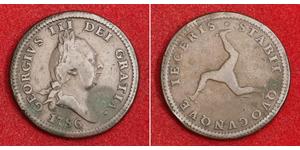1 Penny Isle of Man Copper George III (1738-1820)
1786, Isle of Man (British Dependency), George III. Copper 1 Penny Coin.
Mint Year: 1786 Reference: KM-9. 1. Denomination: 1 Penny Condition: Greenish deposits (vendigris), otherwise F+ Weight: 15,73gm Material: Copper Diameter: 33mm
Obverse: Wreathed bust of George III right. Date (1786) below. Legend: GEORGIVS II DEI GRATIA . Exergue: 1786 Reverse: Three legs conjoined at the thigh (triskelion). Legend: QUOCUQUE IECERIS . STABIT . ("However it is tested it will pass.")
The Isle of Man (Manx: Ellan Vannin), sometimes referred to simply as Mann (/mæn/; Manx: Mannin [ˈmanɪn]), is a self-governing British Crown dependency in the Irish Sea between Great Britain and Ireland. The head of state is Queen Elizabeth II, who holds the title of Lord of Mann and is represented by a Lieutenant Governor. Defence is the responsibility of the United Kingdom. Insurance and online gambling generate 17% of GNP each, followed by information and communications technology and banking with 9% each. The island has been inhabited since before 6500 BC. Gaelic cultural influence began in the 5th century AD, and the Manx language, a branch of the Gaelic languages, emerged. In 627, Edwin of Northumbria conquered the Isle of Man along with most of Mercia. In the 9th century, Norsemen established the Kingdom of the Isles. Magnus III, King of Norway, was King of Mann and the Isles between 1099 and 1103. In 1266, the island became part of Scotland under the Treaty of Perth, after being ruled by Norway. After a period of alternating rule by the kings of Scotland and England, the island came under the feudal lordship of the English Crown in 1399. The lordship revested into the British Crown in 1765, but the island never became part of the 18th-century Kingdom of Great Britain or its successors the United Kingdom of Great Britain and Irelandand the present-day United Kingdom. It retained its internal self-government.
For centuries, the island’s symbol has been the so-called “three legs of Mann” (Manx: Tree Cassyn Vannin), a triskelion of three legs conjoined at the thigh. The Manx triskelion, which dates back with certainty to the late 13th century, is of uncertain origin. It has been suggested that its origin lies in Sicily, an island which has been associated with the triskelion since ancient times.
The symbol appears in the island’s official flag and official coat of arms, as well as its currency. The Manx triskelion may be reflected in the island’s motto, Latin: Quocunque jeceris stabit, which appears as part of the island’s coat of arms. The Latin motto translates into English as “whichever way you throw, it will stand” or “whithersoever you throw it, it will stand”. It dates to the late 17th century when it is known to have appeared on the island’s coinage. It has also been suggested that the motto originally referred to the poor quality of coinage which was common at the time—as in “however it is tested it will pass”.
George III (George William Frederick; 4 June 1738 – 29 January 1820) was King of Great Britain and King of Ireland from 25 October 1760 until the union of these two countries on 1 January 1801, after which he was King of the United Kingdom of Great Britain and Ireland until his death. He was concurrently Duke of Brunswick-Lüneburg and prince-elector of Hanover in the Holy Roman Empire until his promotion to King of Hanover on 12 October 1814. He was the third British monarch of the House of Hanover, but unlike his two predecessors he was born in Britain and spoke English as his first language. Despite his long life, he never visited Hanover.
George III’s long reign was marked by a series of military conflicts involving his kingdoms, much of the rest of Europe, and places further afield in Africa, the Americas and Asia. Early in his reign, Great Britain defeated France in the Seven Years' War, becoming the dominant European power in North America and India. However, many of its American colonies were soon lost in the American Revolutionary War, which led to the establishment of the United States. A series of wars against revolutionary and Napoleonic France, over a twenty-year period, finally concluded in the defeat of Napoleon in 1815.
In the latter half of his life, George III suffered from recurrent and, eventually, permanent mental illness. Medical practitioners were baffled by this at the time, although it is now generally thought that he suffered from the blood disease porphyria. After a final relapse in 1810, a regency was established, and George III’s eldest son, George, Prince of Wales, ruled as Prince Regent. On George III’s death, the Prince Regent succeeded his father as George IV. Historical analysis of George III’s life has gone through a “kaleidoscope of changing views” which have depended heavily on the prejudices of his biographers and the sources available to them.
(1537 X 725pixels, file size: ~247K)
Posted by: anonymous 2018-09-16
CoinWorldTV 1786, Isle of Man (British Dependency), George III. Copper 1 Penny Coin. Mint Year: 1786 Reference: KM-9. 1. Denomination: 1 Penny Condition: Greenish deposits (vendigris), otherwise F+ Weight: 15,73gm Material: Copper Diameter: 33mm Obverse: Wreathed bust of George III rig ...
(1000 X 500pixels, file size: ~149K)
Posted by: anonymous 2015-12-05
Ausländische Münzen und Medaillen Großbritannien-Isle of Man Georg III. 1760-1820. Penny 1786. K.M. 9.1. Vorzüglich
(1200 X 591pixels, file size: ~266K)
Posted by: anonymous 2015-09-28
Isle of Man. George III (1760-1820). Penny, 1786 (Ae - 15,71g). KM 9.1 Very fine.
20 Centesimo Italy / Kingdom of Italy (1861-1946) Copper/Nic ...
group has 4 coins / 1 prices
⇑











-300-150-EMvBwcI0yKwAAAEqtsFDRaZa.jpg)







